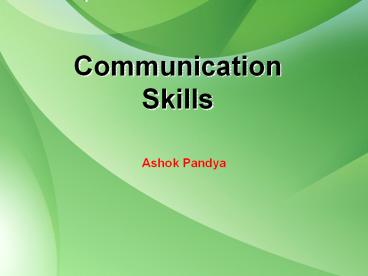Communication skills - PowerPoint PPT Presentation
Title:
Communication skills
Description:
How to communicate with our community.types,basics of communication – PowerPoint PPT presentation
Number of Views:84
Title: Communication skills
1
CommunicationSkills
- Ashok Pandya
2
Introduction
- The exchange of information, ideas and knowledge
between sender and receiver through an accepted
code of symbols. - Two way process
- The term communication, derived from a Latin
term communicare. - Sender-Encoding-Mediums-Decoding-Receiver-Feedback
3
Process of Communication
encode
decode
Medium
Sender
Receiver
Feedback
4
Noise in Communication
- Physical Noise (channel)
- Psychological Noise
- Reasons
- Faulty background, surrounding noise, high
volume, illegible handwriting - (semantic)Ambiguous sentence structure, faulty
grammar, misspelling, incorrect pronunciation or
punctuation
5
General Technical Communication
- General
- Contains a general message
- Informal in style and approach
- No set pattern
- Mostly oral
- Not always for a specific audience
- No use of technical terms or graphics
- Technical
- Contains a technical message
- Mostly formal in style and approach
- Follows a set pattern
- Both oral and written
- Always for a specific audience
- Frequently involves jargons, graphics etc.
6
Meaning in Communication
- Language employs a combination of words to
communicate ideas in a meaningful way. - By changing the word order in a sentence, you can
change its meaning, and make it meaningless. - E.X. I eat rice only.
- I only eat rice.
7
Characteristics of Language
- 1-Artificial
- Its a man made system.
- Man modifies meanings of words as per the need.
- E.X. nice-means good
- Its Latin root nescire means to be ignorant
- And in 13th century it meant stupid, foolish
8
Characteristics of Language
- 2-Resticted
- When we think and translate our thoughts into
language, some meaning is lost in process. - E.X.-my school
9
Characteristics of Language
- 3-Abstract
- It represents a generalized idea.
- E.X.-dress, table
- 4-Arbitrary
- No direct relationship between word and the
object it represents. - E.X.-table can be called anythinng
10
Characteristics of Language
- 5-Creative
- Generates many words in many meanings.
- E.x.-mouse, virus, edutainment
- 6-Repititive
- It improves or reduces effectiveness of
communication. - E.x.-A couple of girls are riding their bicycles.
- All of you meet together to see me in the
afternoon at 3 p.m.
11
Characteristics of Language
- 7-Recursive
- No limit of any potential length of a sentence.
- Generates any number of additional parts in a
sentence. - He borrowed a pen from mewhich was not mine.and
was given to me by someone
12
Levels of Communication
- Extra personal (human non human,(dog))
- Intra personal (individual)
- Inter personal (among people)
- Organizational (-internal operational-external
operational-personal) - Mass (large reach-impersonal-presence of a
gatekeeper)
13
Flow of Communication
- Downward (managers-subordinates)
- Upward (Subordinates-managers)
- Lateral or Horizontal (same level, peers)
- Diagonal or Cross-wise
14
Communication Networks
- Formal Network
- Chain network
- Y- network(through leader only)
- Wheel network(direct contact)
- Circle network(no direct)
- All channel network
15
Communication Networks
- Informal Network
- Single strandGrapevine Communication Grapevine
communication is the informal communication
network within an organization. - Gossip (one passes info. to all)
- Probability( each person tells other at random)
- Cluster (pass info. To selected only)
16
Technical Communication
- Oral Forms
- Face-to-face communication
- Telephone Talk
- Meetings
- Seminars
- Conferences
- Dictation
- Instructions
- Presentations
- Group discussions
- Interviews (employment/press)
- Video conferences
- Voice conferences
- Written Forms
- Memos
- Letters
- E-mails
- Faxes
- Notices
- Circulars
- Newsletters
- Reports
- Proposals
- Research papers
- Bulletins
- Brochures
- Manuals
- In-house journals
17
Conclusion
- Your communication skills can make a difference
between being hired and fired. - Will will find a way.
- Practice makes a man perfect
18
AUDIANCE
- How much do they already know about my topic?
- What do they think about my topic?
- What are their goals (need)?
- What is their level of understanding?
- What medium will support the message the best
e-mail, letter, memo, report, proposal, etc.?































